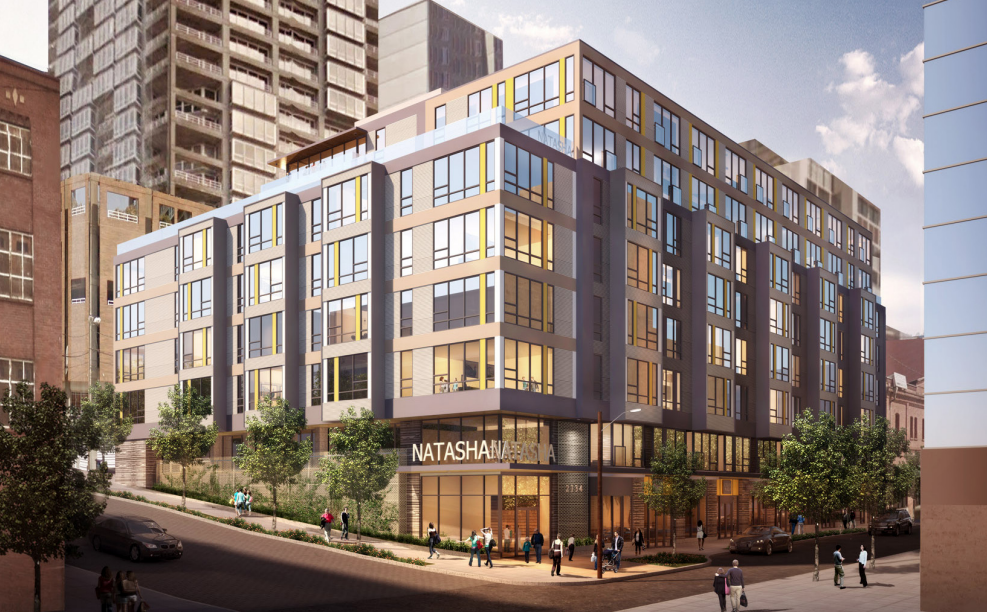
Another Belltown surface parking lot will soon meet its doom. In its place, The Natasha (aka 2134 Western Avenue) will rise up as a modern, eight-story mixed-use buildings. Plans for the structure show seven floors of residential over one story of commercial space. The project is located on the southeast corner of Western Avenue and Blanchard Street, just mere blocks from the heart of Belltown, the waterfront, and Pike Place Market. The architecture firm Clark Design Group, PLLC, is leading the project design into the Recommendation phase of Design Review after two rounds of early design guidance. Tonight, the project proposal will face the Downtown Design Review Board for final comments.
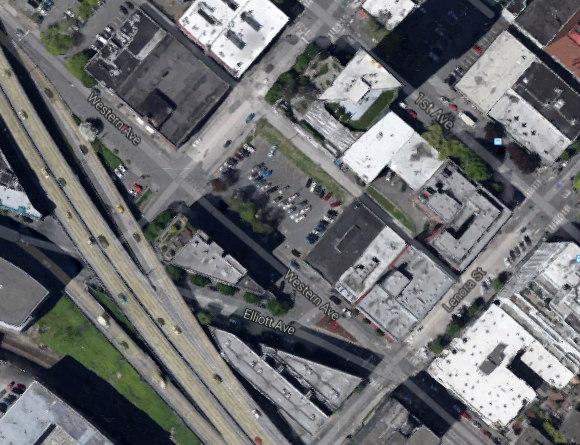
The Natasha will sit on a half block site, currently home to nearly 21,600 square feet of surface parking. The plans call for 152 residential dwelling units on the top seven floors while 5,655 square feet of ground floor retail will be present at the bottom. 153 vehicle parking stalls and at least 76 bike parking spaces will be provided within the structure. Initially, three ground floor retail units will be offered, but these will be created with flexibility for up to five retail units if desired in the future. Residential units will range from studios to 2-bedroom apartments–a rarity in Seattle’s multifamily residential construction boom–while the floor plans for the residential units will vary. The shape of the building has allowed the architects to play with a variety of sizes and shapes for units, which should give future tenants choice in unit arrangements and amenities.
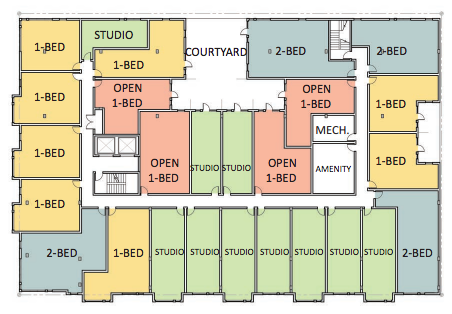
What should be clear from the building perspective and the floor plan above is that The Natasha will be a large, rectangular building. This kind of infill is always a challenge to make visually interesting, but the architects have managed to pull this off in an elegant fashion. They’ve deployed a simple design that focuses on the modern and linear through quality metallic materials and projecting facades. The projecting facades may just be the most prominent, practical, and important feature of The Natasha. These repetitive projections along the public frontages deeply enhance–and even reinforce–the linear, columnar nature of the building. They also seek to reduce the bulk of the overall structure while providing overhead weather protection to pedestrians below.
Less noticeable features of the project include the upper floors and green roof. In a further effort to reduce bulk, the architects cleverly setback the upper floors, which ease the height of the structure over streets below and in respect to surrounding buildings. The green roof also goes virtually unseen by passerby on the streets. But in keeping with a very earthy and green design, the top floors get a serious treatment that will give residents intimate, vegetated spaces while upping the green factor and sustainability of the building.
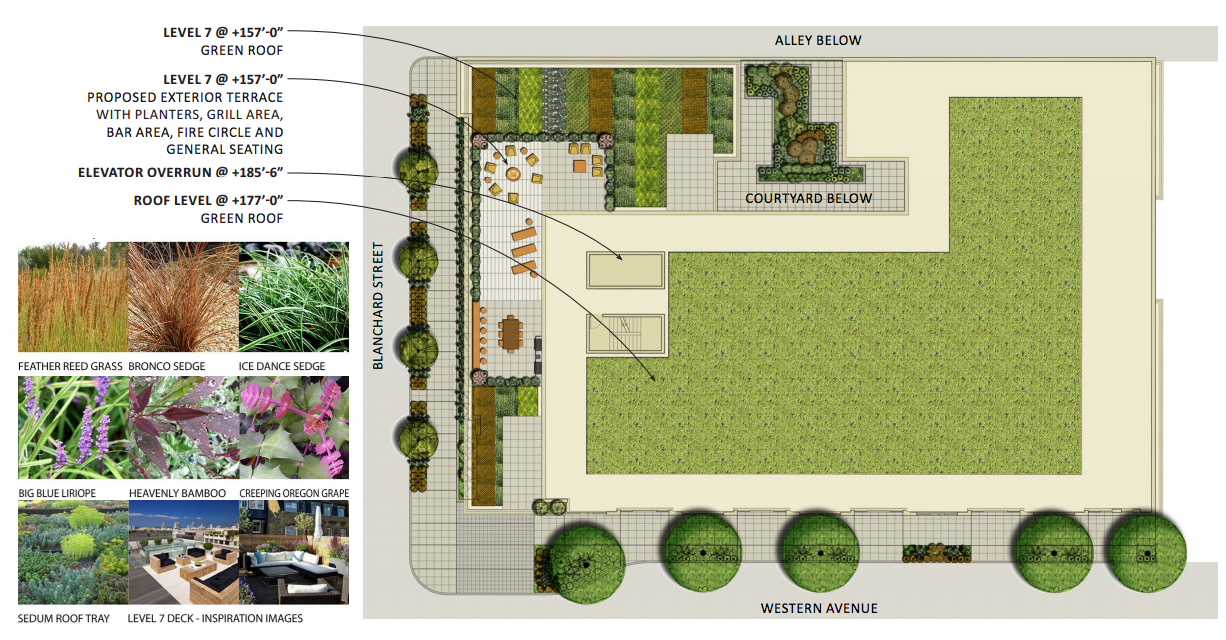
Western Avenue is an important pedestrian street due to its connection from Pike Place Market on one end to the Olympic Sculpture Park on the other. While portions north of here are not exactly active, Seattle plans to have this become a more prominent street (it’s designated as a Class II Pedestrian Street). The architects have carefully responded to this by placing ground floor retail along this frontage as opposed to Blanchard Street. The Western Avenue frontage will remain entirely unobstructed with access to the underground parking garage instead coming from the northwest-southeast alleyway via Blanchard Street. Frontages will get minor improvements like new street trees; but despite Blanchard Street’s green street designation, little attention will be placed on that frontage. In fact, the Blanchard Street frontage will mostly see a blank wall, but hanging vegetation could add some visual interest this side.
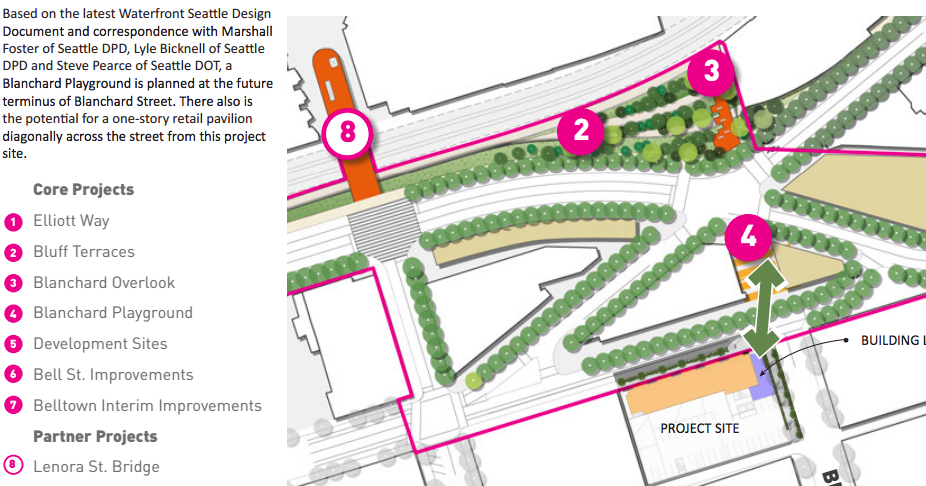
One big drawback for the site is its proximity to the Viaduct; it’s within eyeshot of the loud, smelly monstrosity. Fortunately, the freeway is planned to come down in the next few years. The Waterfront Seattle plan envisions a major transformation of the right-of-way from a four-lane elevated highway plus on-/off-ramps to a tamed two-to-three-lane street to serve local circulation. The streets will be lined with trees and see the creation of new park spaces–like a playground to be kitty-corner to The Natasha. Some of the right-of-way could become future developable parcels. Other local amenities could be laid down within blocks, including an overlook on Blanchard Street, terraced space, and a new pedestrian bridge over the railway track to the waterfront via Lenora Street.
As an eight-story structure, the project falls within conformance with the City’s zoning regulations that allow up to 85 feet for mixed-used development (the site is zoned DMR/C 85/65). With such height, there’s no doubt that the building’s upper floors will command incredible views of Elliott Bay and the Olympic Mountains beyond. But more than that, the character of the area will be greatly strengthened and elevated by The Natasha in a space that was too long deadened by the car and emptiness.
How To Get Involved
If you’re interested in attending the community design review meeting for this project, you can do so tonight. The Downtown Design Review Board will meet at City Hall in Room L280, located at 600 Fifth Avenue. The design review meeting begin promptly at 5.30pm. Alternatively, if you wish submit comments in written form, you can do so by e-mailing Beth Hartwick, Project Planner, at Beth.Hartwick@seattle.gov and the Department of Planning and Development (DPD) at PRC@seattle.gov.
For more design review materials and upcoming meetings, see DPD’s design review page.
Stephen is a professional urban planner in Puget Sound with a passion for sustainable, livable, and diverse cities. He is especially interested in how policies, regulations, and programs can promote positive outcomes for communities. With stints in great cities like Bellingham and Cork, Stephen currently lives in Seattle. He primarily covers land use and transportation issues and has been with The Urbanist since 2014.



